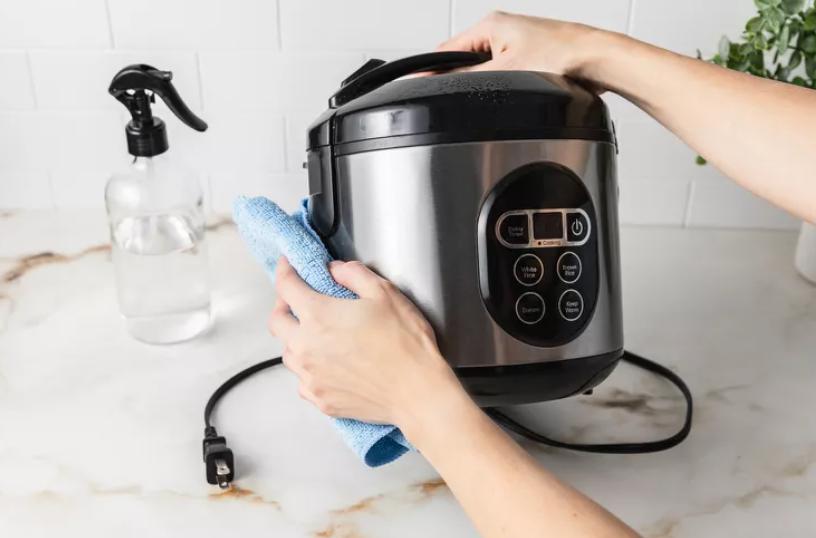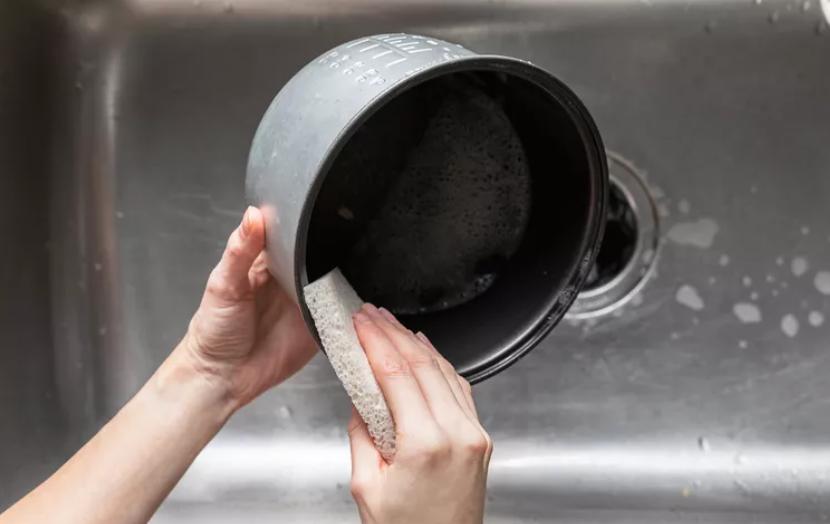Cleaning your rice cooker regularly is essential for its longevity and optimal performance. Proper care ensures your rice cooker continues to cook delicious rice consistently. By following the steps outlined in this guide on how to clean rice cooker, you can maintain your appliance in excellent condition, preventing any buildup or damage. Regular cleaning not only extends the life of your rice cooker but also guarantees that it operates efficiently, providing perfectly cooked rice every time. Keep your rice cooker in top-notch shape with just a little attention and routine maintenance.

Why Regular Cleaning is Essential for Your Rice Cooker?
Regular cleaning of your rice cooker is essential for several reasons. First, it prevents the buildup of food residue, which can harbor bacteria and cause unpleasant odors. This is especially important for maintaining the hygiene of the food you prepare.
Second, proper cleaning helps maintain the performance of your rice cooker. Food debris left unattended can affect the heating element and the overall cooking process, resulting in unevenly cooked rice or even malfunctions. By keeping your rice cooker clean, you ensure it functions efficiently, giving you perfectly cooked rice every time.
Lastly, regular cleaning ensures the longevity of your appliance. Over time, accumulated grime and residue can cause wear and tear, leading to the deterioration of parts and the need for replacements. A clean rice cooker is less likely to experience such issues, thus extending its lifespan.
How to Clean Rice Cooker: A Step-by-Step Guide
Unplug and Let It Cool
Before starting the cleaning process, always unplug your rice cooker and allow it to cool down completely. This step is crucial for safety, preventing any risk of burns or injury. Cooling down also helps protect internal components, ensuring that the cleaning process doesn’t cause any damage and that your rice cooker continues to perform well for a long time.
Disassemble Removable Parts
Remove all removable parts from the rice cooker, including the inner pot, lid, spatulas, measuring cups, and steam trays. Carefully disassemble these components according to the manufacturer’s instructions to prevent any damage. Proper disassembly ensures that you can clean all parts effectively and maintain the longevity of your rice cooker. Always handle each part gently during the process.
Clean the Inner Pot
To clean the inner pot, first use warm, soapy water and a soft sponge to scrub away any rice or water residue. Be sure to avoid abrasive materials, as they can damage the non-stick coating. After cleaning, rinse the pot thoroughly to remove all soap, and allow it to air dry completely before storing it. This ensures longevity and keeps your rice cooker in optimal condition.
Clean the Lid and Accessories
Wipe the lid and any removable accessories with a damp cloth or sponge. If the lid is detachable, wash it with warm, soapy water for a deeper clean. Focus on crevices and corners where grime may collect. After washing, rinse well and ensure all parts are dry before reassembling them.
Wipe the Heating Plate and Exterior
Use a damp cloth to wipe down the heating plate and exterior of your rice cooker, removing any residue or spills. Be careful not to get water in the electrical components. For stubborn stains, a mild vinegar solution can help clean. Once cleaned, make sure all parts are completely dry before plugging the rice cooker back in.
Common Mistakes to Avoid When Cleaning Your Rice Cooker
Not Removing All Rice Residue
Leaving rice residue in your cooker can lead to the growth of bacteria and the development of unpleasant odors. Over time, leftover rice can become a breeding ground for germs and mold, making your rice cooker unhygienic. Always ensure you thoroughly remove all traces of rice after each use, and clean the cooker properly to maintain its longevity and freshness.
Using Harsh Chemicals or Abrasives
Avoid using harsh chemicals or abrasive cleaning materials when cleaning your rice cooker. These can scratch or damage the non-stick surfaces, as well as other sensitive parts of the appliance. Such damage not only affects the performance but also shortens the overall lifespan of the rice cooker. Instead, opt for gentle cleaners and soft cloths to ensure its longevity and efficiency.
Skipping the Regular Maintenance
Regular maintenance is essential to ensure your rice cooker remains in optimal working condition. Skipping routine cleanings can lead to a buildup of residue, which may cause the cooker to malfunction or operate inefficiently. Cleaning after each use prevents the accumulation of food particles and stains, helping to extend the lifespan of your rice cooker and ensure consistent performance.

How to Maintain Your Rice Cooker for Long-Term Use?
How Often Should You Clean Your Rice Cooker?
It’s recommended to clean your rice cooker after each use to maintain its performance and hygiene. For thorough maintenance, deep clean it every few weeks, making sure to clean both removable and non-removable parts. Regular cleaning helps prevent buildup, ensures your rice cooker works efficiently, and prolongs its lifespan, keeping it in optimal condition for future meals.
Inspecting and Tightening Loose Parts
Regularly inspect your rice cooker for any loose parts, such as screws, handles, or lids. Tighten them as necessary to prevent any malfunction or safety hazards. Ensuring that all components are secure will help maintain the appliance's optimal performance and longevity. Regular maintenance can also reduce the risk of accidents and ensure that your rice cooker continues to function safely and efficiently.
Best Practices for Storing Your Rice Cooker
Store your rice cooker in a cool, dry place when not in use to ensure its longevity. Make sure it’s completely dry before storing to prevent the growth of mold and mildew. Keeping it in a dust-free area will help maintain its cleanliness and efficiency, ensuring it functions properly when you need it next. Regularly checking for any residue will also extend its lifespan.
Conclusion
Maintaining and cleaning your rice cooker is essential for its longevity, efficiency, and consistent performance. Regular care not only helps preserve the appliance’s functionality but also ensures that your rice cooker continues to deliver perfectly cooked rice each time you use it. Knowing how to clean rice cooker properly is key to keeping it in top condition. By following the simple steps outlined in this guide, you can remove built-up residue, prevent odors, and avoid malfunctions. Proper maintenance will extend the life of your rice cooker, allowing you to enjoy flawless meals for years to come.
FAQs
How Often Should I Clean My Rice Cooker?
You should clean your rice cooker after every use to prevent food residue from building up and to maintain its performance.
Can I Use Abrasive Cleaners on My Rice Cooker?
No, you should avoid using abrasive cleaners as they can damage the non-stick surfaces and other components of the rice cooker.
How Do I Remove Stubborn Stains from My Rice Cooker?
For stubborn stains, use a mild solution of vinegar and water. Let it sit for a few minutes before wiping it down with a soft cloth.
